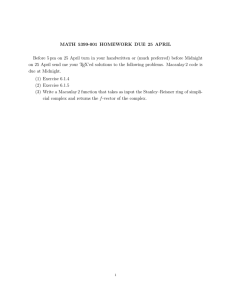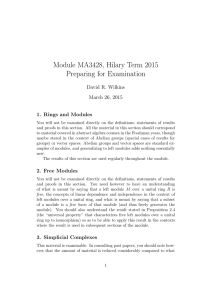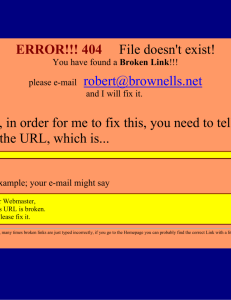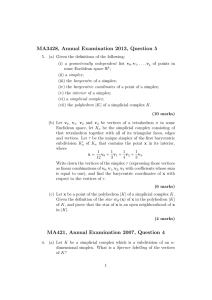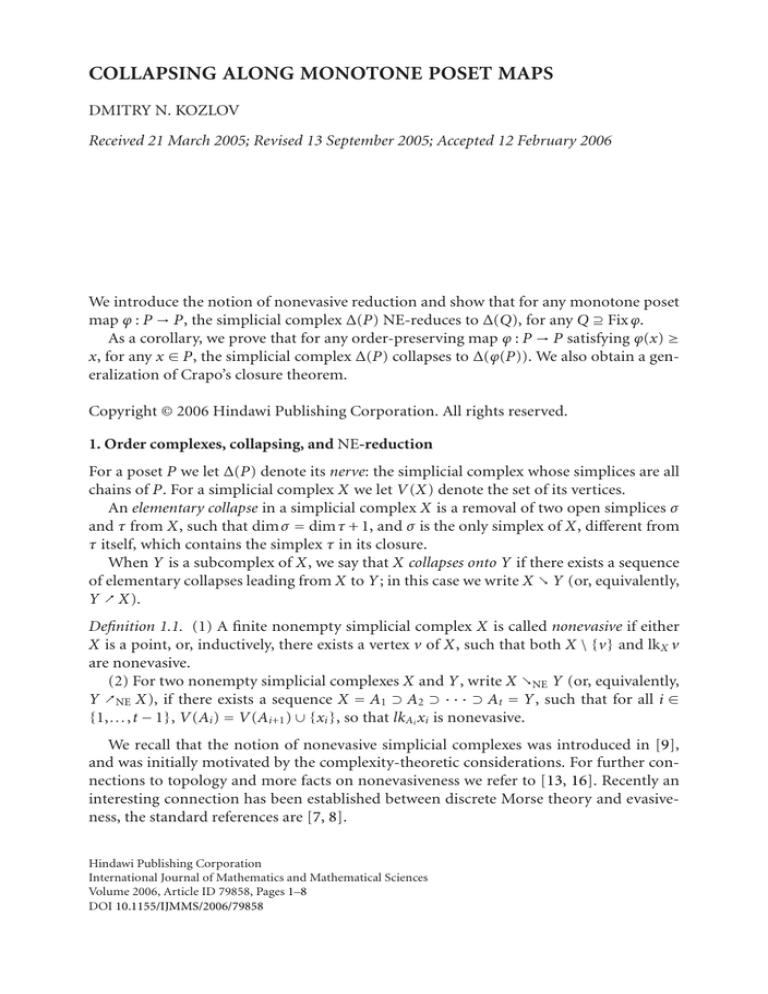
COLLAPSING ALONG MONOTONE POSET MAPS
DMITRY N. KOZLOV
Received 21 March 2005; Revised 13 September 2005; Accepted 12 February 2006
We introduce the notion of nonevasive reduction and show that for any monotone poset
map ϕ : P → P, the simplicial complex Δ(P) NE-reduces to Δ(Q), for any Q ⊇ Fix ϕ.
As a corollary, we prove that for any order-preserving map ϕ : P → P satisfying ϕ(x) ≥
x, for any x ∈ P, the simplicial complex Δ(P) collapses to Δ(ϕ(P)). We also obtain a generalization of Crapo’s closure theorem.
Copyright © 2006 Hindawi Publishing Corporation. All rights reserved.
1. Order complexes, collapsing, and NE-reduction
For a poset P we let Δ(P) denote its nerve: the simplicial complex whose simplices are all
chains of P. For a simplicial complex X we let V (X) denote the set of its vertices.
An elementary collapse in a simplicial complex X is a removal of two open simplices σ
and τ from X, such that dimσ = dimτ + 1, and σ is the only simplex of X, different from
τ itself, which contains the simplex τ in its closure.
When Y is a subcomplex of X, we say that X collapses onto Y if there exists a sequence
of elementary collapses leading from X to Y ; in this case we write X Y (or, equivalently,
Y X).
Definition 1.1. (1) A finite nonempty simplicial complex X is called nonevasive if either
X is a point, or, inductively, there exists a vertex v of X, such that both X \ {v} and lkX v
are nonevasive.
(2) For two nonempty simplicial complexes X and Y , write X NE Y (or, equivalently,
Y NE X), if there exists a sequence X = A1 ⊃ A2 ⊃ · · · ⊃ At = Y , such that for all i ∈
{1,...,t − 1}, V (Ai ) = V (Ai+1 ) ∪ {xi }, so that lkAi xi is nonevasive.
We recall that the notion of nonevasive simplicial complexes was introduced in [9],
and was initially motivated by the complexity-theoretic considerations. For further connections to topology and more facts on nonevasiveness we refer to [13, 16]. Recently an
interesting connection has been established between discrete Morse theory and evasiveness, the standard references are [7, 8].
Hindawi Publishing Corporation
International Journal of Mathematics and Mathematical Sciences
Volume 2006, Article ID 79858, Pages 1–8
DOI 10.1155/IJMMS/2006/79858
2
Collapsing along monotone poset maps
Several classes of simplicial complexes are known to be nonevasive. Perhaps the simplest example is provided by the fact that all cones are nonevasive. A more complicated
family of nonevasive simplicial complexes is obtained by taking the order complexes of
the noncomplemented lattices, see [10].
In the situation described in Definition 1.1(2), we say that the simplicial complex X
NE-reduces to its subcomplex Y . The following facts about NE-reduction are useful for
our arguments.
Fact 1. If X1 and X2 are simplicial complexes, such that X1 NE X2 , and Y is an arbitrary
simplicial complex, then X1 ∗ Y NE X2 ∗ Y .
Here the symbol ∗ denotes the simplicial join of two simplicial complexes, see [14].
That X1 ∗ Y NE X2 ∗ Y follows by induction from the facts that if v is any vertex of a
simplicial complex X, then we have lkX ∗Y v = (lkX v) ∗ Y and (X ∗ Y ) \ {v} = (X \ {v}) ∗
Y , for any v ∈ V (X).
To NE-reduce X1 ∗ Y to X2 ∗ Y , simply take the sequence of vertices x1 ,...,xt ∈ V (X1 )
which NE-reduces X1 to X2 . We have lkX1 ∗Y (x1 ) = (lkX1 (x1 )) ∗ Y . In turn, the simplicial
complex (lkX1 (x1 )) ∗ Y is nonevasive: this is seen by induction on the number of vertices
of the first factor, with the base given by the fact that all cones are nonevasive. Removing
x1 from X1 ∗ Y yields the simplicial complex (X1 \ {x1 }) ∗ Y , hence, continuing in this
way, we will NE-reduce X1 ∗ Y all the way to X2 ∗ Y .
Fact 2. The reduction X NE Y implies X Y , which in turn implies that Y is a strong
deformation retract of X.
2. Monotone poset maps
Next we define a class of maps which are particularly suitable for our purposes.
Definition 2.1. Let P be a poset. An order-preserving map ϕ : P → P is called a monotone
map, if for any x ∈ P either x ≥ ϕ(x) or x ≤ ϕ(x).
If x ≥ ϕ(x) for all x ∈ P, then ϕ is called a decreasing map, analogously, if x ≤ ϕ(x) for
all x ∈ P, then ϕ is called an increasing map.
We remark here the fact that while a composition of two decreasing maps is again a
decreasing map, and, in the same way, a composition of two increasing maps is again an
increasing map, the composition of two monotone maps is not necessarily a monotone
map.
Example 2.2. Let P be the lattice of all subsets of {1,2}, and define ϕ(S) = S ∪ {2}, and
γ(T) = T \ {1}, for all S,T ⊆ {1,2}. The composition T ◦ S maps all the subsets to {2}, in
particular it is not a monotone map.
On the other hand, any power of a monotone map is again monotone. Indeed, let ϕ :
P → P be monotone, let x ∈ P, and say x ≤ ϕ(x). Since ϕ is order-preserving, we conclude
that ϕ(x) ≤ ϕ2 (x), ϕ2 (x) ≤ ϕ3 (x), and so forth. Hence x ≤ ϕN (x) for arbitrary N.
Dmitry N. Kozlov 3
The following proposition shows that monotone maps have a canonical decomposition in terms of increasing and decreasing maps.
Proposition 2.3. Let P be a poset, and let ϕ : P → P be a monotone map. There exist unique
maps α,β : P → P, such that
(i) ϕ = α ◦ β;
(ii) α is an increasing map, whereas β is a decreasing map;
(iii) Fix α ∪ Fix β = P.
Proof. Set
⎧
⎪
⎨ϕ(x),
α(x) := ⎪
⎩x,
⎧
⎪
⎨ϕ(x),
β(x) := ⎪
⎩x,
if ϕ(x) > x,
(2.1)
otherwise,
if ϕ(x) < x,
(2.2)
otherwise.
Clearly, Fix α ∪ Fix β = P. Let us see that ϕ(x) = α(β(x)), for any x ∈ P. This is obvious
if ϕ(x) ≥ x, since then α(β(x)) = α(x) = ϕ(x) by (2.1) and (2.2), respectively. Assume
ϕ(x) < x, then β(x) = ϕ(x), hence α(β(x)) = α(ϕ(x)). Since ϕ is order-preserving, ϕ(x) < x
implies ϕ(ϕ(x)) ≤ ϕ(x). Thus (2.1) gives ϕ(x) ∈ Fix α, and we conclude that α(β(x)) =
α(ϕ(x)) = ϕ(x).
To see that α is an increasing map, we just need to see that it is order-preserving. Since
α either fixes an element or maps it to a larger one, the only situation which needs to be
considered is when x, y ∈ P, x < y, and α(x) = ϕ(x). However, under these conditions we
have α(y) ≥ ϕ(y) ≥ ϕ(x) = α(x), and so α is order-preserving. That β is a decreasing map
can be seen analogously. Finally, the uniqueness follows from the fact that each x ∈ P
must be fixed by either α or β, and the value ϕ(x) determines which one will fix x.
3. The main theorem and implications
Prior to this work, it has been known that a monotone map ϕ : P → P induces a homotopy
equivalence between Δ(P) and Δ(ϕ(P)), see [4, Corollary 10.17]. It was also proved in
[4] that if the map ϕ satisfies the additional condition ϕ2 = ϕ, then ϕ induces a strong
deformation retraction from Δ(P) to Δ(ϕ(P)).
The latter result was strengthened in [11, Theorem 2.1], where it was shown that whenever ϕ is an ascending (or descending) closure operator, Δ(P) collapses onto Δ(ϕ(P)).
There this fact was used to analyze the effect of the folding operation on the corresponding Hom complexes, see also [1–3, 12].
The next theorem strengthens and generalizes the results from [4, 11].
Theorem 3.1. Let P be a poset, and let ϕ : P → P be a monotone map. Assume P ⊇ Q ⊇
Fix ϕ, P \ Q is finite, and, for every x ∈ P \ Q, P<x ∪ P>x is finite, then Δ(P) NE Δ(Q), in
particular, Δ(P) collapses onto Δ(Q).
4
Collapsing along monotone poset maps
Remarks 3.2. (1) Note that when P is finite, the conditions of the Theorem 3.1 simply
reduce to: P ⊇ Q ⊇ Fix ϕ.
(2) Under conditions of Theorem 3.1, the simplicial complex Δ(P) collapses onto the
simplicial complex Δ(Q), in particular, the complexes Δ(P) and Δ(Q) have the same simple homotopy type, see [5].
(3) Under conditions of Theorem 3.1, the topological space Δ(Q) is a strong deformation retract of the topological space Δ(P).
(4) Any poset Q satisfying P ⊇ Q ⊇ ϕ(P) will also satisfy P ⊇ Q ⊇ Fix ϕ, hence Theorem
3.1 will apply. In particular, for finite P, we have the following corollary.
Corollary 3.3. For any poset P, and for any monotone map ϕ : P → P, satisfying conditions
of Theorem 3.1, Δ(P) NE Δ(ϕ(P)).
It is easy to prove Theorem 3.1, once the following auxiliary result is established.
Proposition 3.4. Let P be a poset, and let ϕ : P → P be a monotone map. Assume x ∈
P, such that ϕ(x) = x, and P<x ∪ P>x is finite, then Δ(P<x ) ∗ Δ(P>x ) is nonevasive. More
precisely, if ϕ(x) < x, then Δ(P<x ) is nonevasive, and if ϕ(x) > x, then Δ(P>x ) is nonevasive.
Proof. Since the expression Δ(P<x ) ∗ Δ(P>x ) is symmetric with respect to inverting the
partial order of P, it is enough, without loss of generality, to only consider the case ϕ(x) <
x. Let us show that in this case Δ(P<x ) is nonevasive. We proceed by induction on |P<x |.
If |P<x | = 1, then the statement is clear, so assume |P<x | ≥ 2.
Let ψ : P<x → P<x denote the restriction of ϕ. It is easy to see that ψ is a monotone map
of P<x . To verify that Δ(P<x ) NE Δ(P≤ϕ(x) ), order the elements of P<x \ P≤ϕ(x) following
an arbitrary linear extension in the decreasing order, say P<x \ P≤ϕ(x) = {a1 ,...,at }, and
i , where P i = P \
ai < a j , for i < j. By the choice of the order of ai ’s, we have P<ai = P<a
i
{a1 ,...,ai−1 }. Therefore, by the induction assumption, Δ(P<ai ) is nonevasive for all 1 ≤
i ≤ t, and we have
1
2
t+1
NE Δ P<x
NE · · · NE Δ P<x
Δ P<x = Δ P<x
= Δ P≤ϕ(x) .
(3.1)
On the other hand, Δ(P≤ϕ(x) ) is a cone, hence it is nonevasive, and therefore Δ(P<x ) is
nonevasive as well. It follows that Δ(P<x ) ∗ Δ(P>x ) is nonevasive.
Proof of Theorem 3.1. The proof is by induction on |P \ Q|. The statement is trivial when
|P \ Q| = 0, so assume |P \ Q| ≥ 1.
To start with, we replace the monotone map ϕ with a monotone map γ satisfying
γ(P) ⊆ Q and Fix γ = Fix ϕ. To achieve that objective we can set γ := ϕN , where N = |P \
Q|. With this choice of γ, the inclusion γ(P) ⊆ Q follows from the assumption that Fix ϕ ⊆
Q, since Fix γ = γ(P).
/ γ(P), we have x = γ(x), hence by Proposition 3.4
Take arbitrary x ∈ P \ Q. Since x ∈
we know that lkΔ(P) x = Δ(P<x ) ∗ Δ(P>x ) is nonevasive. This means Δ(P) NE Δ(P \ {x}).
Let ψ : P \ {x} → P \ {x} be the restriction of γ. Clearly, ψ is a monotone map, and
Fix ψ = Fix γ. This implies that Fix ψ ⊆ Q, hence, by the induction hypothesis Δ(P \ {x})
NE Δ(Q). Summarizing, we conclude that Δ(P) NE Δ(Q).
Dmitry N. Kozlov 5
On the enumerative side, we obtain the following generalization of Crapo’s closure
theorem from 1968, see [6, Theorem 1].
Corollary 3.5. Let P be a finite poset with 0 and 1, and let ϕ : P → P be an increasing map.
Assume P ⊇ Q ⊇ Fix ϕ, and Q ∩ ϕ−∞ (1) = {1}. Then,
ϕ∞ (z)=1
⎧
⎨ μQ (0
, 1
),
μP (0,z) = ⎩
0,
if 0 ∈ Fix ϕ,
otherwise.
(3.2)
Here ϕ∞ is the stabilization of ϕ, say ϕ∞ := ϕ|P| , so ϕ−∞ (1) denotes the set of all elements of
P which map to 1 after a sufficiently high iteration of ϕ.
Before we give the proof, recall the following convention: whenever P is a poset with 0
and 1, we let P̄ denote P \ {0, 1}.
Proof of Corollary 3.5. Assume first that 0 ∈ Fix ϕ, hence 0, 1 ∈ Q, and, since ϕ is increasing, ϕ−∞ (0) = {0}. Set R := (P \ ϕ−∞ (1)) ∪ {0, 1}, that is, R is the set of all elements of P̄
which will not map to 1, no matter how high iteration of ϕ we take, with the maximal
and the minimal elements attached. Let ψ : R̄ → R̄ be the restriction of ϕ. Clearly, ψ is a
monotone map, and Fix ψ = Fix ϕ \ {0, 1}.
Since R̄ ⊇ Q̄ ⊇ Fix ψ, we conclude that Δ(R̄) collapses onto Δ(Q̄); in particular the
simplicial complexes Δ(R̄) and Δ(Q̄) have the same Euler characteristic. By Ph. Hall’s
theorem, see [15], for any poset P with a maximal element and a minimal element we
have χ(Δ(P̄)) = μP (0, 1), therefore here we conclude that μQ (0, 1) = μR (0, 1).
On the other hand, by definition of the Möbius function, we have the equality
z∈P μP (0,z) = 0, which can be rewritten as z∈ϕ−∞ (1) μP (0,z) = − z∈
/ ϕ−∞ (1) μP (0,z). Sim
−∞
/ ϕ (1) is equivalent to the conilarly, μR (0, 1) = − x∈R\{1} (0,x). Since the condition z ∈
dition z ∈ R \ {1}, and R<x = P<x , for any x ∈ R, we conclude that μQ (0, 1) = μR (0, 1) =
z∈ϕ−∞ (1) μP (0,z).
/ Fix ϕ. If ϕ∞ (0) = 1, then the statement follows from the
Consider now the case 0 ∈
definition of the Möbius function, since then ϕ∞ (z) = 1 for all z ∈ P. Assume ϕ∞ (0) = 1.
We can define a new map ψ by changing the value of ϕ in one element:
⎧
⎨0
,
if x = 0,
ψ(x) = ⎩
ϕ(x), otherwise.
(3.3)
Clearly, ψ is a monotone function, Fix ψ = Fix ϕ ∪ {0}, and ϕ−∞ (1) = ψ −∞ (1). Hence, the
first part of the proof applies, and we conclude that
ψ ∞ (z)=1
μP (0,z) =
ϕ∞ (z)=1
μP (0,z) = μQ (0, 1),
(3.4)
6
Collapsing along monotone poset maps
Z
Hollow
1
Y
0
X
−1
H
Hollow
Unit disc
Figure 4.1. A house with two rooms.
for any Q such that P ⊇ Q ⊇ Fix ψ, and such that Q ∩ ϕ−∞ (1) = {1}. Choose Q = (P≥ϕ(0) \
ϕ−∞ (1)) ∪ {0, 1}. Since ϕ(0) ∈
/ ϕ−∞ (1), the poset Q has only one atom ϕ(0), thus we have
μQ (0, 1) = 0, and the proof is complete.
4. NE-reduction and collapses
The NE-reduction can be used to define an interesting equivalence relation on the set of
all simplicial complexes.
Definition 4.1. Let X and Y be simplicial complexes. Recursively, it is said that X NE Y
if X NE Y , or Y NE X, or if there exists a simplicial complex Z, such that X NE Z and
Y NE Z.
Clearly, if X is nonevasive, then X NE pt, but is the opposite true? The answer to that
is “no.” To see this, consider the standard example of a space which is contractible, but
not collapsible: let H be the so-called house with two rooms, see Figure 4.1.
The space H is not collapsible, hence nonevasive, see [5] for an argument. On the other
hand, we leave it to the reader to see that it is possible to triangulate the filled cylinder C
given by the equations |z| ≤ 1, x2 + y 2 ≤ 1, so that C NE H.
The analogous equivalence relation, where NE and NE are replaced by and ,
is called the simple homotopy equivalence; its equivalence classes are called simple homotopy types. The celebrated theorem of J.H.C. Whitehead states that the simplicial
complexes with the simple homotopy type of a point are precisely those which are contractible, see [5]. Therefore, the class of the simplicial complexes which are NE-equivalent
to a point relates to nonevasiveness in the same way as contractibility refers to collapsibility. Clearly, this means that this class should constitute an interesting object of study.
Dmitry N. Kozlov 7
We conjecture that the NE-equivalence is much finer than the Whitehead’s simple
homotopy type. We make two conjectures: a weak conjecture and a strong one.
Conjecture 4.2. There exist finite simplicial complexes X and Y having the same simple
homotopy type, such that X NE Y .
Conjecture 4.3. There exists an infinite family of finite simplicial complexes {Xi }∞
i=1 , which
all have the same simple homotopy type, such that Xi NE X j , for all i = j.
Again, in the simple homotopy setting, the phenomenon of the Conjectures 4.2 and 4.3
is governed by an algebraic invariant called the Whitehead torsion, namely: a homotopy
equivalence between finite connected CW-complexes is simple if and only if its Whitehead torsion is trivial, see [5, (22.2)]. It is enticing to hope for an existence of some similar
invariant in our NE-setting.
Finally, let us remark that whenever we have simplicial complexes X NE Y , there exists
a simplicial complex Z, such that X NE Z NE Y . Indeed, assume A NE B NE C, for
some simplicial complexes A, B, and C. Let S = V (A) \ V (B), and T = V (C) \ V (B). Let
D be the simplicial complex obtained by attaching to A the vertices from T in the same
way as they would be attached to B ⊆ A. Clearly, since the links of the vertices from S
did not change, they can still be removed in the same fashion as before, and therefore we
have A NE D NE C. Repeating this operation several times and using the fact that the
reductions NE (as well as NE ) compose, we prove the claim.
Acknowledgments
We would like to thank the Swiss National Science Foundation and ETH-Zürich for the financial support of this research. We also thank the referee for several valuable comments.
This research is supported by Swiss National Science Foundation Grant PP002-102738/1.
References
[1] E. Babson and D. N. Kozlov, Topological obstructions to graph colorings, Electronic Research Announcements of the American Mathematical Society 9 (2003), 61–68.
, Complexes of graph homomorphisms, Israel Journal of Mathematics 152 (2006), 285–
[2]
312.
, Proof of the Lovász Conjecture, to appear in Annals of Mathematics. Second Series,
[3]
http://arxiv.org/abs/math.CO/0402395.
[4] A. Björner, Topological methods, Handbook of Combinatorics, Vol. 1, 2 (R. Graham, M.
Grötschel, and L. Lovász, eds.), Elsevier, Amsterdam, 1995, pp. 1819–1872.
[5] M. M. Cohen, A Course in Simple-Homotopy Theory, Graduate Texts in Mathematics, vol. 10,
Springer, New York, 1973.
[6] H. H. Crapo, Möbius inversion in lattices, Archiv der Mathematik (Basel) 19 (1968), no. 6, 595–
607 (1969).
[7] R. Forman, Morse theory for cell complexes, Advances in Mathematics 134 (1998), no. 1, 90–145.
, Morse theory and evasiveness, Combinatorica 20 (2000), no. 4, 489–504.
[8]
[9] J. Kahn, M. Saks, and D. Sturtevant, A topological approach to evasiveness, Combinatorica 4
(1984), no. 4, 297–306.
8
Collapsing along monotone poset maps
[10] D. N. Kozlov, Order complexes of noncomplemented lattices are nonevasive, Proceedings of the
American Mathematical Society 126 (1998), no. 12, 3461–3465.
, A simple proof for folds on both sides in complexes of graph homomorphisms, Proceedings
[11]
of the American Mathematical Society 134 (2006), no. 5, 1265–1270.
, Chromatic numbers, morphism complexes, and Stiefel-Whitney characteristic classes,
[12]
Geometric Combinatorics (E. Miller, V. Reiner, and B. Sturmfels, eds.), IAS/Park City Mathematics Series, vol. 14, American Mathematical Society, Rhode Island; Institute for Advanced
Study (IAS), New Jersey, in press, http://arxiv.org/abs/math.AT/0505563.
[13] H. Kurzweil, A combinatorial technique for simplicial complexes and some applications to finite
groups, Discrete Mathematics 82 (1990), no. 3, 263–278.
[14] J. R. Munkres, Elements of Algebraic Topology, Addison-Wesley, California, 1984.
[15] R. P. Stanley, Enumerative Combinatorics. Vol. 1, Cambridge Studies in Advanced Mathematics,
vol. 49, Cambridge University Press, Cambridge, 1997, corrected reprint of the 1986 original.
[16] V. Welker, Constructions preserving evasiveness and collapsibility, Discrete Mathematics 207
(1999), no. 1–3, 243–255.
Dmitry N. Kozlov: Institute of Theoretical Computer Science, Swiss Federal Institute of Technology
Zurich, 8092 Zurich, Switzerland
E-mail address: dkozlov@inf.ethz.ch


